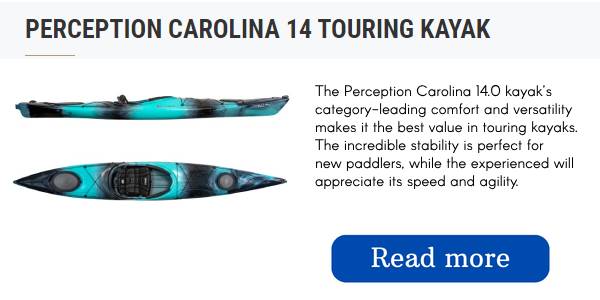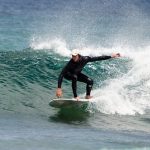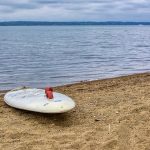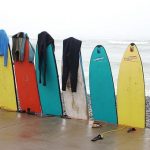If you choose the wrong surfboard, you’ll have a terrible time surfing. Make sure to pick the right one so you can enjoy the sport. If you choose the wrong board, it will be difficult.
Surfing is a great activity and finding the right surfboard is half the fun. But if you don’t know much about surfboards, then you may find it difficult to find the right one. This is because it can be difficult to figure out what kind of surfboard you need – especially if you are a beginner or intermediate surfer.
A beginner will need a different board than someone who is already proficient at catching waves and riding them. There are different types of boards for barrel riding, noseriding, big wave riding, high-performance riding, and retro riding.
There are a number of factors that can affect a surfer’s performance, such as the size and shape of their surfboard, the fins, and the rocker. Even experienced surfers can find it hard to keep track of all of these variables.
Types of Surfboards
Surfboards have been evolving since the 1940s, and they now come in many shapes and sizes. Below are six of the largest categories of surfboards to give you a general overview of types of surfboards, but know that there are many more subcategories and alternative shapes not listed below.
High-Performance Shortboard
It’s the go-to choice for almost any surfer. Most people envision a modern surfboard as being the go-to choice for any surfer. High-performance boards are generally short, have low volume, are pointed at the nose, and have hard rails near the tail.
They also have some combination of concave and double concave on the bottom contours which makes them good for speed and aggressive maneuvers.
In other words, there is a lot of variety when it comes to modern shortboards. They can be short and stubby, or long and thin, and everything in between. Most of these boards come with five fin boxes, so you can ride them as either quads or thrusters.
However, some still have glassed-in fins.
It’s important to be honest about your surf ability and fitness level when shopping for a high-performance shortboard, and to select a board with enough volume to help you catch waves.
Longboard
The first modern surfboards were longboards, which were shaped from fiberglass and foam in the 1950s. These surfboards maintained the general shape of the traditional Hawaiian olos.
The longboard has gone through many evolutions, from the traditional single-fin board to the high-performance boards used in world tour events.
Longboards are surfboards that are longer and wider than the average surfboard. They typically range from 9 to 12 feet in length. Longboards are prominent for their full and round noses.
Longboards are usually long and wide, which makes them easy to paddle and catch waves. Therefore, they are a great option for beginners who are learning how to surf.
Longboards can be as long as 10 feet, but the best performance is usually between 9 and 9 1/2 feet. Traditional noseriders are usually between 9 1/2 and 10 1/2 feet.
Mid-Length
A mid-length surfboard is any surfboard that is between 7 and 8 feet 6 inches long. It is shorter than a longboard but longer than a shortboard. There are several types of surfboards that are popular among surfers.
These include funboards, retro single-fins, and oversized fish designs. Mid-lengths are a happy medium between longboards and regular boards, giving you some of the advantages of both.
They’re more maneuverable than longboards, but still provide a good amount of glide and paddle power.
There are many professional level surfers who spend most of their time on mid-length boards, which are often great for beginners transitioning from longboards to shortboards.
Fish
The traditional fish surfboard is a short, stocky, twin-fin board with relatively straight sides and a deep, rounded back end that was developed in the early 1970s. There is a wide variety of fish-style boards available today, from boards with keel fins reminiscent of older boards to hybrids that are more similar to modern shortboards.
A “fish” board is generally 4’6″ to 5’8″, wide and flat with straight-ish rails and a swallow tail. These boards are fast and skatey, making them great for soft, crappy waves, but not as good in hollow or larger waves.
Gun
A big wave board is a long and narrow board that is good for paddle power and control in the pocket, especially when going fast. Guns are shorter and have narrower noses than longboards, with a drawn-in pintail.
They have relatively low volume compared to longboards of the same length, although modern guns are starting to add a bit of extra volume through beak noses and a bit more width forward of center.
Boards with four fins are known as quads, those with three fins are thrusters, and those with one fin are single-fins. Guns often have a V-shaped indentation near the tail to provide additional control.
Mini Gun
The minigun is designed for waves that are large but not quite in the extra large range, usually double to triple overhead barrels. These surfboards often look like small guns, ranging in size from 6’6″ to around 8’0″.
Research The Market
If you want to thoroughly explore surfing, you’ll need to learn about everything from surfboard measurements to surfboard length and reading the surf conditions.
Most surfers who are either intermediate or advanced would rather have a surfboard that is easy to move around on, rather than one that is more stable. If you’re looking for a more relaxed surfing experience or if you’re not that experienced, you can always go for a larger board.
That being said, surfboard sizes are much like pants. They are available in every size imaginable. There are various different board types. Less speed means a higher fitness level.
A rider who gets a new surfboard will usually want to start surfing right away, but it is a good idea to go through a thruster setup first. Your skill level in surfing has a big impact on the outcome. Do not expect to achieve great things when you are just starting to surf.
Surfboard Outlines
Choose a board with an outline that you feel comfortable with in terms of volume and familiarize yourself with the nose, tail, and rails.
The shape of an object can have a big effect on how its different parts fit together.
The three main types of surfboard outlines are those with a parallel outline, a more curved outline, and a hybrid of the two.
These items can all be found at different surf shops. Now that you understand the different types, let’s take a closer look at them.
Parallel Outlines
Parallel outline boards are all over the place. Longboards have them, and shortboards have them.
The term “parallel” is not used in a literal sense here because if you take the time to imagine a completely parallel board, it will look more like a plank than a board. So, the term “parallel” is applied to boards that do not feature exaggerated curves.
This category is usually filled with long, straight rail boards.
If you’re a surfer who loves going downhill, then you’ll love parallel outlines. The board being more inclined with the surface of the wave allows it to pick up more speed.
Curved Outlines
The boards have a curved outline and long curves that spread out along their entire length. Freestyle skaters most often choose boards that are shorter than average, as well as some hybrid boards.
Boards with a flat rocker and a curved outline are good for picking up speed in short distance runs.
Some of the most popular curved outline boards is the SUPER quadrophenia, which has full-on curved outlines with a low rocker that pushes the board down.
Hybrid Outline
The hybrid boards are a good choice for those who like certain features of both the classic and the new boards. If someone does not want to commit to either a straight or curved outline, a curved outline makes sense.
The hybrid type of board is very practical and can be bent into a lot of different shapes. Usually, hybrid surfboards feature curves up the nose.
The rails are placed in parallel so that surfers can get the best acceleration on straight line dives.
Size Limits
Finally, we can get to the thick of it. If you can fit your feet on the surfboard, then it can still be surfed. There’s no definitive answer for what is too short. Jamie O’Brien and Julian Wilson are famous riders who frequently use 58-inch surfboards. They often experiment with these boards, pushing them to see how far they can go.
Go short with your board for easy and quick cuts.
You also need to think about the surfboard pins when you’re deciding how long your surfboard should be. If the waves are rounded, it makes the surfing experience more interesting.
Riders maintain balance more easily by taking this route, even in hollow surfs.
There are boards that are good for all types of waves, and there are also boards that are better for a certain type of wave.
What Size Surfboard Is the Best?
It all comes down to performance and outlines. Long and giant boards just aren’t as sexy. Most smaller surfboards are easier to maneuver, store, and carry.
Why have a boat keel when you don’t need one.
The shorter and narrower size of the board makes it easier to paddle and more manageable than it used to be.
Backing a car from a garage without a servo automatic steering wheel can be difficult. Same thing.
Surfboard Volume
Believe it or not, when the surfboard first came along, there were no precise measures of how one should look. Surfboards back then were made however the surfer saw fit. No one knew the volume of their board, and no one was scared.
Before, surfers had to just go with whatever waves they could find. However, now they can pick and choose which waves they want to surf. Computers and technology have given rise to Computer Assisted Design, or CAD.
Manufacturers would be able to see their products before committing to a machine to produce them.
This is the first time that surfers can have a board that is exactly what they want down to the last detail.
In other words, manufacturers typically label their products according to the age, weight, and height of the surfer, rather than the surfer having to provide these measurements themselves.
Finding the Right Volume
The truth is, what really matters is the volume of the surfboard. The size of a surfboard is not as important as the volume.
The way the foam is distributed throughout the drink is just as important as the foam itself.
New surfers should stick to smaller waves and favorable surf conditions, so the new board measurements shouldn’t be too different from the norm.
Trying out different boards is the best way to find the right one, but not everyone can try every board before they buy it. A good alternative is to use a surfboard volume calculator and then try out the boards on the beach.
Swallow Tail
Swallow tails provide surfers with excellent speed retention while changing directions.
This type of tail is good for supportive steep waves, but they are more difficult to control when moving from one side of the board to the other.
Asymmetrical Tail
The reason the tail is asymmetrical makes sense for boards that have long lines and different shapes.
Why? Some spots are known to constantly generate either right-handed or left-handed waves.
If a surfer is determined to surf in a specific location and gets a board that is designed for the waves in that area, it is an excellent choice. There is a lot of distinction between the toe and heel sides of asymmetrical trails and surfboard sizes, so they have a lot of predetermined parameters.
This type of surfboard is not the best choice for beginners, however it can be useful and produce great results when used under the right conditions.




